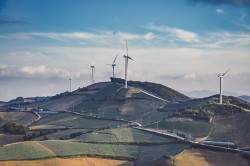How supergrids can support the integration of renewable energy
In the past, most electricity grids were mainly based on centrally produced power, in relatively few plants, within national borders. Today electricity grids need to support decentralised generation and enable international distribution to manage electricity surpluses. “Europe is not only a multi-state society, but also a multi-vendor society. Our challenges are to ensure constant power transmission by removing the technical barriers between the different systems, and share essential information with different stakeholders, such as manufacturers and transmission system operators,” says Carlos Ugalde-Loo, academic at Cardiff University School of Engineering (Wales, UK). He is collaborating with the European project Best Paths, designed to help integrate renewables into Europe’s energy mix. Structured around five large-scale pilots, the project aims to develop novel network technologies to increase pan-European transmission network capacity and system flexibility. Most existing transmission lines use alternating current (AC). The use of direct current (DC) can, however, decrease power loss over large distances. “When disturbances occur, you can prevent faults whenever the current crosses zero in an AC-system [the zero-crossing is the point of the AC waveform at which there is no voltage present, ed. note]. In a DC-system there are no natural zero-crossings [because the electric current flows in a constant direction, ed. note]. As a result, the time available to react to faults is limited to a scale of microseconds,” explains Ugalde-Loo. “Therefore, in DC systems we need devices that react faster than in AC-systems. Today in Europe, we only have prototypes of such devices. In China, a couple of DC-transmission systems are already operational, but I'm not convinced they are fully secure,” he says. “Moreover, a growing interconnection capacity means that in addition to energy, system unbalances can be propagated. For instance, the interconnection capacity between France and the UK is currently 2 GW,” Ugalde-Loo adds. "This may increase in the future. If a failure occurs in such connections, there could be a knock-on effect with blackouts in both systems. In a prospective DC system spanning different European countries, if there is an incident at some system interconnection, who will take responsibility for it?” The challenges are not just technological; there are also political obstacles. “The electricity from several Eastern European countries, including Poland and Romania, today largely depends on the availability of cheap coal and lignite,” says Kathleen van Brempt, a Belgian member of the European parliament. “Furthermore, the coal sector represents a lot of jobs in these countries. For this reason, their politicians tend to be more willing to vote in favour of new gas pipelines than for new technologies for renewable electricity, even as we move towards renewable sources as a society”. “But coal-dependent countries aren’t the only ones to be blamed,” she warns. “Take for example my own country, Belgium. If the government doesn't take an irreversible decision about closing the nuclear power plants, investors will remain reluctant to put money into additional renewable generation capacity. As long as the free market offers cheap energy from amortised nuclear plants, the profitability of new renewable electricity power plants is doubtful. Generally, the Scandinavian countries today are closest to a society based on renewable energy sources.” Political resistance also exists in left wing and green movements. They protest against the “visual pollution” of the landscape caused by surface lines on high pylons. Read more:
Keywords
supergrids, energy, renewables
Countries
Belgium, France, Poland, Romania, United Kingdom



